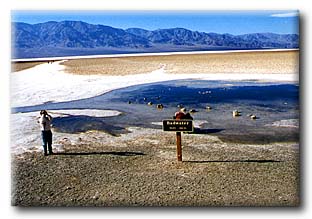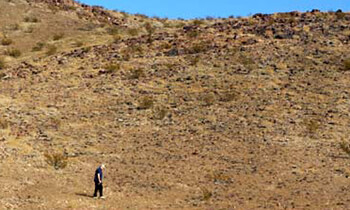DESERT GEOLOGY FIELD TRIPS
1996

Hot Spot It's Always Not
Death Valley's reputation as one of the hottest spots in the world is well deserved. Summer temperatures can easily go into the 120s. But visiting Death Valley in the winter is a different story entirely. Each December, the geology department of Palomar College in San Marcos, California takes a 3-day field trip to Death Valley National Park for students enrolled in any geology course. (Another 3-day field trip goes to Mojave National Preserve each May.)
 |
The geology field trip caravan. |
Heading Out
I leave early Friday evening, jeeping Interstate 15 northeast across the high Mojave Desert. After exiting at Baker, California, I head north on Highway 127 for about 50 miles. It is 11:00 PM by the time I rendezvous with the geology group camped just outside the national park boundary.
About 20 mostly 4-wheel-drive vehicles are assembled here in the darkness, spread out across the sandy wash amidst pitched tents. Everyone is already asleep, and it's deathly still and dark as I cut my engine and step out into the dry, bone-chilling night air. High above the desert floor, a brilliant mob of stars pierces the darkness, silently rioting across the vault of the heavens. It doesn't take long to be cozily zipped in my sleeping bag in the rear of the Jeep.

CB Caravaning
A few other vehicles straggle in throughout the night, and by 6:00 AM Saturday a strangely attired assemblage of young and old geology students is foraging for breakfast and adjusting CB radio antennas as their breath steams from their nostrils. Soon, we are breaking camp and lining our vehicles up behind Dr. Spear's Toyota pickup, recognizable by its PANGEA license plate.
 |
The natural bridge off Artist's Drive. |
"This is Mojave Max [Dr. Spear's handle]. The formation you see on the right . . . . Our first turnoff will be at Saratoga Springs Road . . . . this is a habitat for the endangered pupfish . . . those of you who do not have 4-wheel-drive vehicles may want to leave your cars parked at the edge of the highway and . . . ." And so it goes for the next three days.
By midmorning the temperature has risen to a pleasant degree, and by midday, on the valley floor at least, it's downright warmish. We spend daytimes driving from one remarkable geologic site to another while discussing via CB radio, various roadside features along the way. Mojave Max also fields numerous questions en route and while stopped for brief lectures at scheduled locations. There are often short hikes to inspect more remote features as well. Students are also required to record and photograph their experiences as part of their class assignment.

|
|
The Devil's Golf course. |
Camping & Camaraderie
The first day we take Route 178 north up the valley floor stopping at Saratoga Springs in search of pupfish, Ashford Mill for lunch, Badwater for the salt pan and Artist's Palette for the remarkable geologic colors, before arriving at Furnace Creek.
By the time we have our tents pitched at the base of the Furnace Mountains and supper is cooking on our camp stoves, the sun is setting behind the Panamint Range in the west, and we are all once again bundling up against the cold of the desert night. Dinner, campfires, songs and discussions ensue till everyone turns in early.
The following day finds us caravaning the volcanic wonders of Zabriskie Point, snaking through Twenty Mule Team Canyon and braving the high winds of Dante's View. From here, 5475 feet directly above the Death Valley salt pan, we can simultaneously view the lowest and highest points in the contiguous U.S. -- Badwater (282 feet below sea level) and Mt. Whitney to the west (14,492 feet above sea level).
As the day heats up, we are exploring the Nevada ghost town of Rhyolite, careening our way down the convoluted geology of Titus Canyon, stopping at Scotty's Castle for lunch, peering over the edge of Ubehebe Crater and seeking answers to the mysterious rock trails at The Racetrack. All the while Mojave Max maintains a non-stop geologic mantra either via CB radio or the portable PA he enlists at the numerous stops.
|
The badland topography of Twenty Mule Team Canyon. |
Another chilly night of camping and camaraderie, then we're caravaning west on our final day, exploring the geology of the Sand Dunes, then continuing up the Panamint Mountains to frigid Augesberry Point where we can view Death Valley from the west. Winding over Emigrant Pass and through Wildrose Canyon, we stop at the strange charcoal kilns and have a final lunch before leaving Death Valley National Park for the Trona Pinnacles on the way back south.
If you're interested in this unique manner of exploring the deserts with a fun group of people while getting an edgey-cation at the same time, you might want to check out geology classes. The only costs involved on such trips are individual admission and camping fees required by the National Park Service, in addition to participants providing their own food, lodging and vehicle expenses.
Extended Field Trips
Dr. Steve Spear also conducts annual 8- to 10-day field trips to various locations of geologic interest throughout the western U.S. These field trips provide academic credits and are open to all. Participants must register, just as they would for any other class at Palomar College. (Community college tuition fees are about $13 per unit for California residents.)
The only fees involved are the normal Palomar College tuition/registration fees, in addition to NPS fees and personal travel expenses including gas, camping, food, etc.
- Utah/Arizona Week-long trip - Geology 195. 2 units of credit
Geology of the National Parks and Monuments of the Colorado Plateau, including Zion, Bryce, Capitol Reef, Arches, Canyonlands, Natural Bridges, Monument Valley, and Grand Canyon (North Rim). - Colorado Extended Trip - Geology 195. 3 units of credit
General geology of Colorado and surrounding areas including Sunset Crater, Petrified Forest, Canyon de Chelly, Great Sand Dunes, and Dinosaur National Monument. - Death Valley Week-long Field Trip - Geology 195. 2 units of credit
Very detailed course on the geology of Death Valley. Roads are mostly unpaved, camping is primitive and there are no amenities to be found. Four-wheel-drive vehicles are strongly recommended.
For more information about these programs, call Palomar College at 760-744-1150.or point your browset to the Geology Department Web address. Or try contacting your local college or univeristy for similar programs.
-- A.R. Royo
Share this page on Facebook:
The Desert Environment
The North American Deserts
Desert Geological Terms








